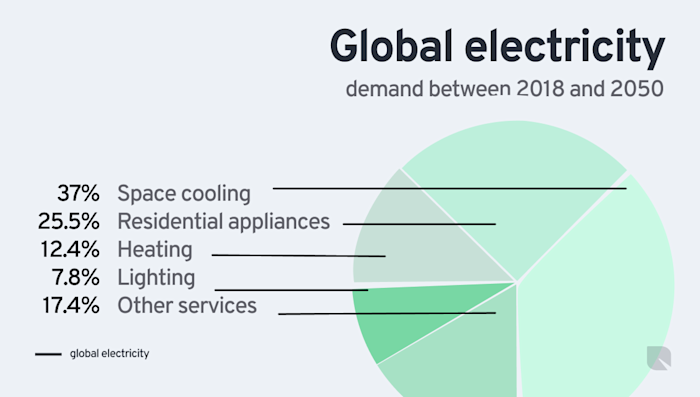How to keep cool without AC
Here are 10 easy tricks to cool down without harming the planet.
Climate change is making the world a warmer place, raising the frequency, intensity, and duration of heat waves, which can be extremely dangerous to human health. Although air conditioning may feel like the best solution to beat the heat (for those who can afford it), it’s nowhere near a climate-friendly option, as it uses large amounts of electricity and releases hydrofluorocarbons, a potent greenhouse gas used in cooling agents.
This doesn’t mean you need to throw your AC unit out of the window, if you have one, but you can still learn how to use it less. So, let’s get down to business: How do we cool down without making climate change worse and our world hotter? Here are a few climate-friendly tips that can help you stay cool without harming the planet.
How to keep cool without air conditioning
As soon as the sun rises, close the shades. Blinds, shutters, or curtains are the most effective ways to prevent heat from penetrating into your house.
Insulate and air-seal your home. Insulation provides a barrier that slows heat exchange. Plus, by improving home insulation, you can save 15% on heating and cooling costs. Investing in double-pane windows can also make a massive difference to your home temperature.
Plant shade trees. Deciduous trees on the south and west side of your home can help cool it down and cut air conditioning needs, as well as improve air and soil quality. Check this guide to find out which trees are most suitable to your needs. If you’re a renter, speak to your landlord and let them know the benefits of planting trees to shade their property.
Cover your rooftop with light-colored, highly reflective materials or plants. Vegetation can lower a roof’s temperature by up to 4 °C (or 40 °F).
Cool yourself down. Stay hydrated, have frequent showers if you need to, or moisten your wrists, ankles, and face with a wet cloth to quickly bring down your body temperature.
As night falls, open those windows. Create a cross breeze by opening windows and doors on opposite ends of the room. Before a predicted hot day, opening windows on your top floor and bottom floor will pull in cool and push out warm air.
Switch to LED bulbs. Incandescent light bulbs produce loads of heat and waste about 90% of the energy they use, so switching to LEDs can help save money and keep your home cool.
Avoid using electric appliances on hot days. Burners and stoves, but also tumble dryers or dishwashers, give off a lot of heat. Switch them on only if really necessary, and instead, prepare a fresh salad (or use a microwave, it produces less heat), wash the dishes in the sink, and take advantage of the heat to air-dry your clothes.
Make a DIY ice fan. Place a bucket of ice in front of a fan. As the air flows over the ice, it will cool down and circulate around the room. Alternatively, take two soda bottles, cut off the ends, and punch holes in the sides. Then strap them to the back of the fan and fill the bottles with ice. Need more ideas? Take a look at these eight ways to create your own DIY air conditioner.
Manage humidity levels. Dehumidifiers won’t cool a room, but can help control the thick air that makes hot days so unpleasant.
Why is air conditioning so bad?
AC currently keeps 1.9 billion households cool, but this figure is expected to rise to 5.5 billion units by 2050. According to the International Energy Agency (IEA), air conditioning will be the biggest factor for growing electricity demand globally by 2050. Just in the US, it currently accounts for about 6% of all electricity production. In a world still dominated by fossil-fuels, this can only mean one thing: more greenhouse gas emissions.

But the problem with air conditioners is not only electricity demand. Hydrofluorocarbons used in air conditioners as cooling agents are a potent greenhouse gas, trapping heat in the atmosphere and causing temperatures to rise. In the 1990s, they replaced chlorofluorocarbons (CFCs), as the latter were found to be strong ozone depleting chemicals.
According to new research, CFCs would have driven 2.5°C of extra warming by 2100 if they hadn’t been outlawed. But switching to HFCs is just picking a slightly less terrible solution: Although HFCs do not deplete the ozone layer, they have up to 9,000 times greater warming potential than carbon dioxide.
Why does this matter?
Climate scientists have been warning us for years: Global warming will make heat waves and other extreme weather events more likely and severe. But these are no longer forecasts, they’re part of today’s reality, and the spring of 2022 has made this clearer than ever.
The June heat wave in Europe shattered several temperature records, with France recording its hottest May ever and observing its earliest 40°C (104°F) in recorded history. Plus, a recent study showed that the south Asian heatwave in March and April was made 30 times more likely to happen by human influence on the climate.
2021 also saw some of the longest wildfires and most violent flash floods on record, and researchers say this could become the new normal. The U.N.'s Intergovernmental Panel on Climate Change (IPCC) recently found that severe heat waves that previously occurred once every 50 years will now likely happen once per decade.
Time to adapt our behavior!
We’re still on time to avert a global catastrophe, but we need to act fast, decisively, and cohesively to achieve global net zero emissions — and we need every single one of us to chip in.
If we zoom in on our daily lives, there are plenty of opportunities to make a difference. Finding creative, low-carbon ways to keep cool without pumping more carbon into the atmosphere is one of those daily actions we can all take to make a dent in climate change. Ultimately, if we really want to get to the root of the problem, the world needs to achieve net zero emissions as soon as possible. As individuals, we can all do our part by shrinking our carbon footprint, offsetting what we can’t reduce, and encouraging our friends and family to do the same. Download Klima to get started today.



